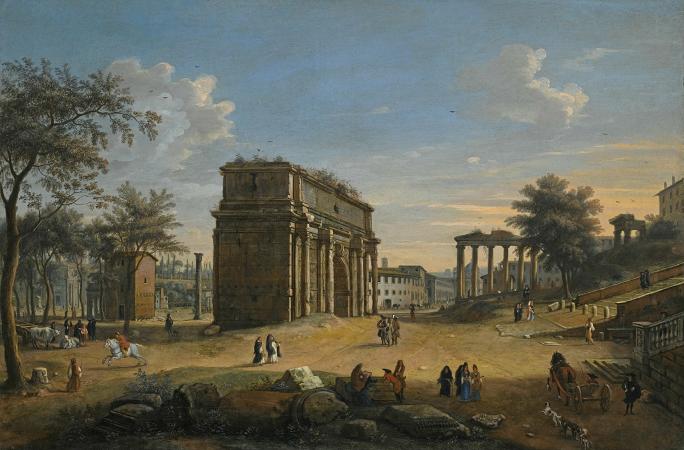Roman Forum (c-700). The Roman Forum, also known by its Latin name Forum Romanum, is a rectangular forum surrounded by the ruins of several important ancient government buildings at the center of the city of Rome. Citizens of the ancient city referred to this space, originally a marketplace, as the Forum Magnum, or simply the Forum. For centuries the Forum was the center of day-to-day life in Rome: the site of triumphal processions and elections; the venue for public speeches, criminal trials, and gladiatorial matches; and the nucleus of commercial affairs. Here statues and monuments commemorated the city's great men. The teeming heart of ancient Rome, it has been called the most celebrated meeting place in the world, and in all history. Located in the small valley between the Palatine and Capitoline Hills, the Forum today is a sprawling ruin of architectural fragments and intermittent archaeological excavations attracting 4.5 million or more sightseers yearly. Many of the oldest and most important structures of the ancient city were located on or near the Forum. The Roman Kingdom's earliest shrines and temples were located on the southeastern edge. These included the ancient former royal residence, the Regia, and the Temple of Vesta, as well as the surrounding complex of the Vestal Virgins, all of which were rebuilt after the rise of imperial Rome. Other archaic shrines to the northwest, such as the Umbilicus Urbis and the Vulcanal, developed into the Republic's formal Comitium. This is where the Senate, as well as Republican government itself, began. The Senate House, government offices, tribunals, temples, memorials and statues gradually cluttered the area. Over time the archaic Comitium was replaced by the larger adjacent Forum and the focus of judicial activity moved to the new Basilica Aemilia. Some 130 years later, Julius Caesar built the Basilica Julia, along with the new Curia Julia, refocusing both the judicial offices and the Senate itself. This new Forum, in what proved to be its final form, then served as a revitalized city square where the people of Rome could gather for commercial, political, judicial and religious pursuits in ever greater numbers. Eventually much economic and judicial business would transfer away from the Forum Romanum to the larger and more extravagant structures to the north. The reign of Constantine the Great saw the construction of the last major expansion of the Forum complex, the Basilica of Maxentius. This returned the political center to the Forum until the fall of the Western Roman Empire almost two centuries later. Unlike the later imperial fora in Rome, which were self-consciously modelled on the ancient Greek plateia public plaza or town square, the Roman Forum developed gradually, organically, and piecemeal over many centuries. This is the case despite attempts, with some success, to impose some order there, by Sulla, Julius Caesar, Augustus and others. By the Imperial period, the large public buildings that crowded around the central square had reduced the open area to a rectangle of about 130 by 50 meters. Its long dimension was oriented northwest to southeast and extended from the foot of the Capitoline Hill to that of the Velian Hill. The Forum's basilicas during the Imperial period, the Basilica Aemilia on the north and the Basilica Julia on the south, defined its long sides and its final form. The Forum proper included this square, the buildings facing it and, sometimes, an additional area extending southeast as far as the Arch of Titus. Originally, the site of the Forum had been a marshy lake where waters from the surrounding hills drained. This was drained by the Tarquins with the Cloaca Maxima. Because of its location, sediments from both the flooding of the Tiber and the erosion of the surrounding hills have been raising the level of the Forum floor for centuries. Excavated sequences of remains of paving show that sediment eroded from the surrounding hills was already raising the level in early Republican times. As the ground around buildings rose, residents simply paved over the debris that was too much to remove.
more...













